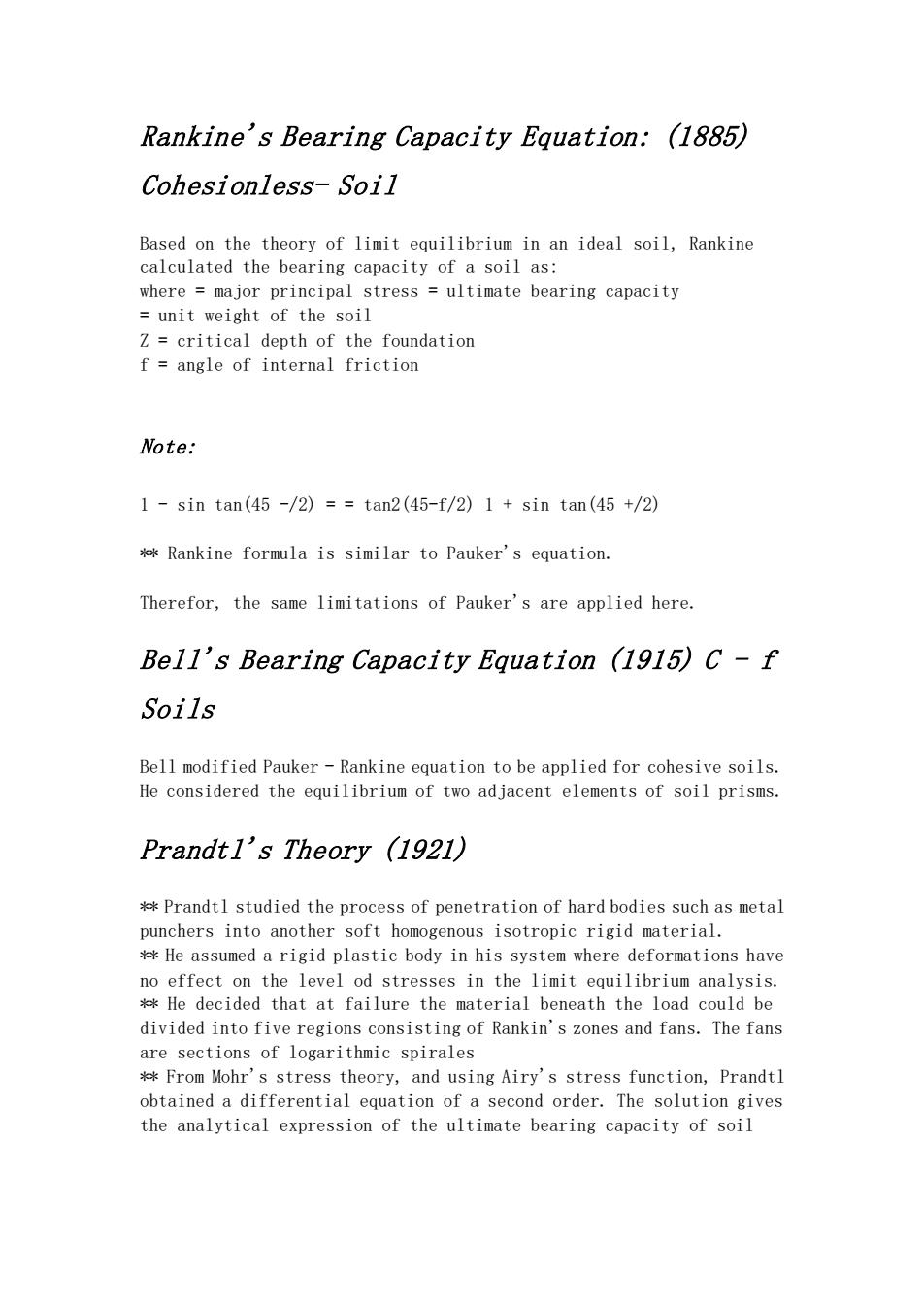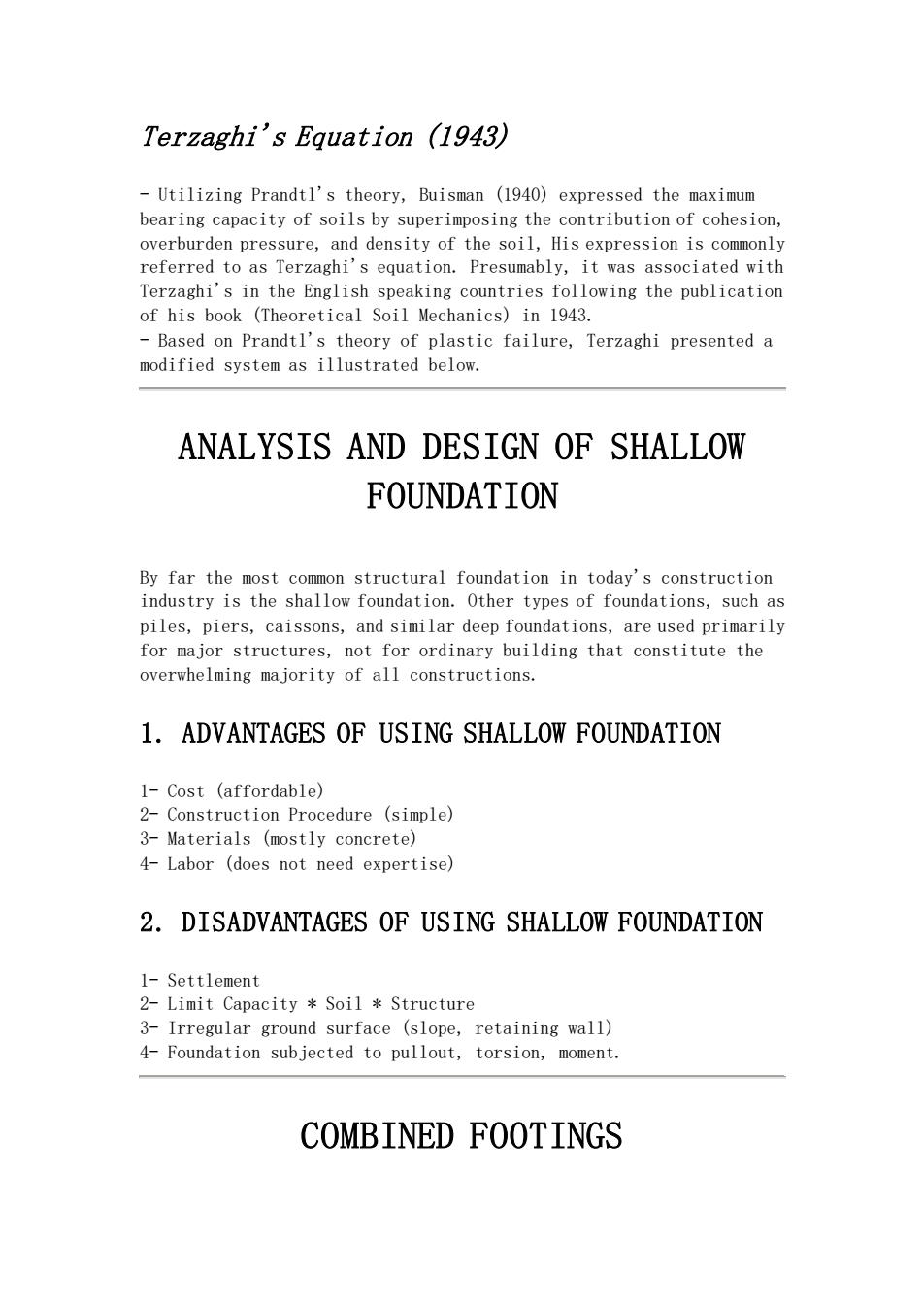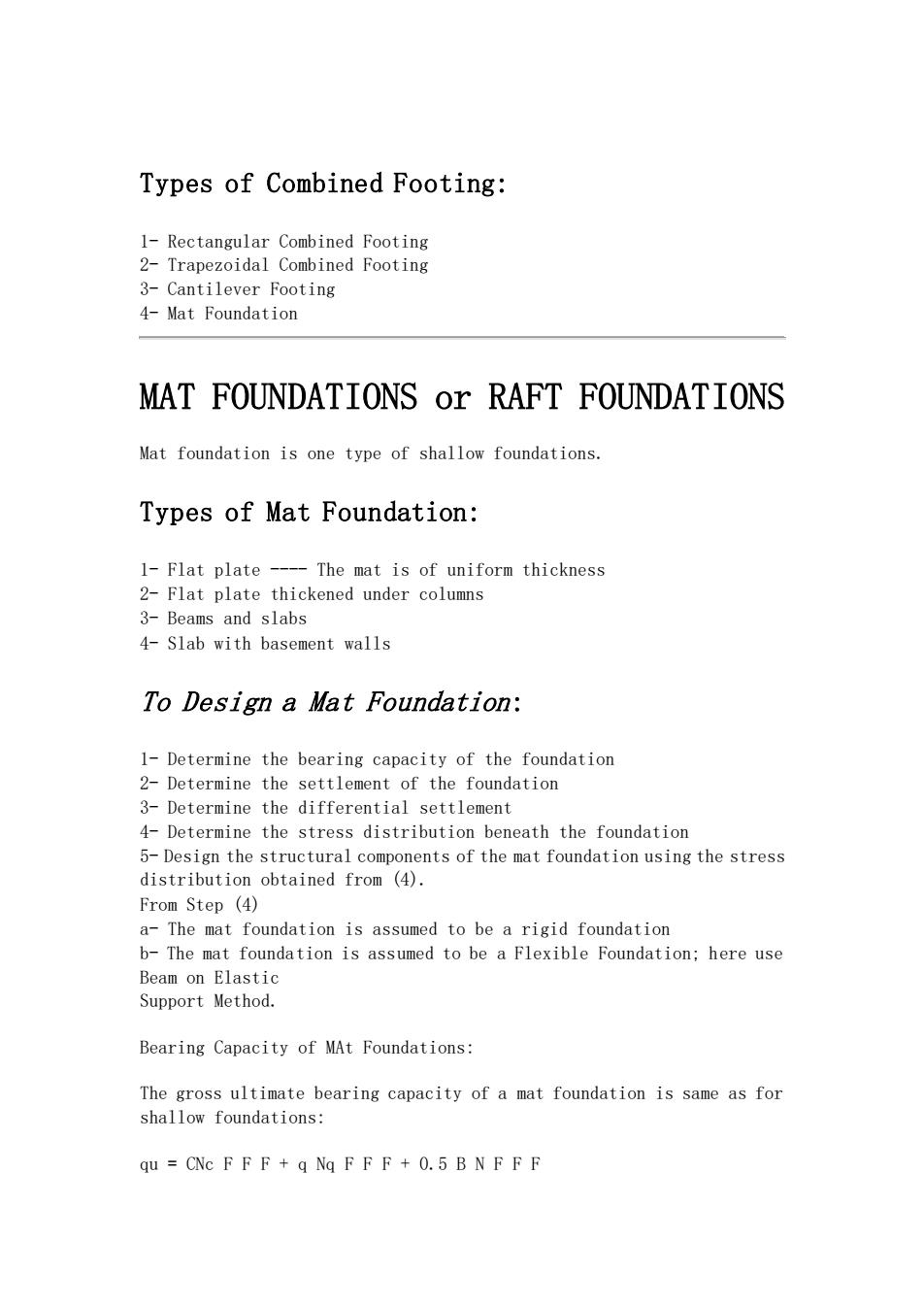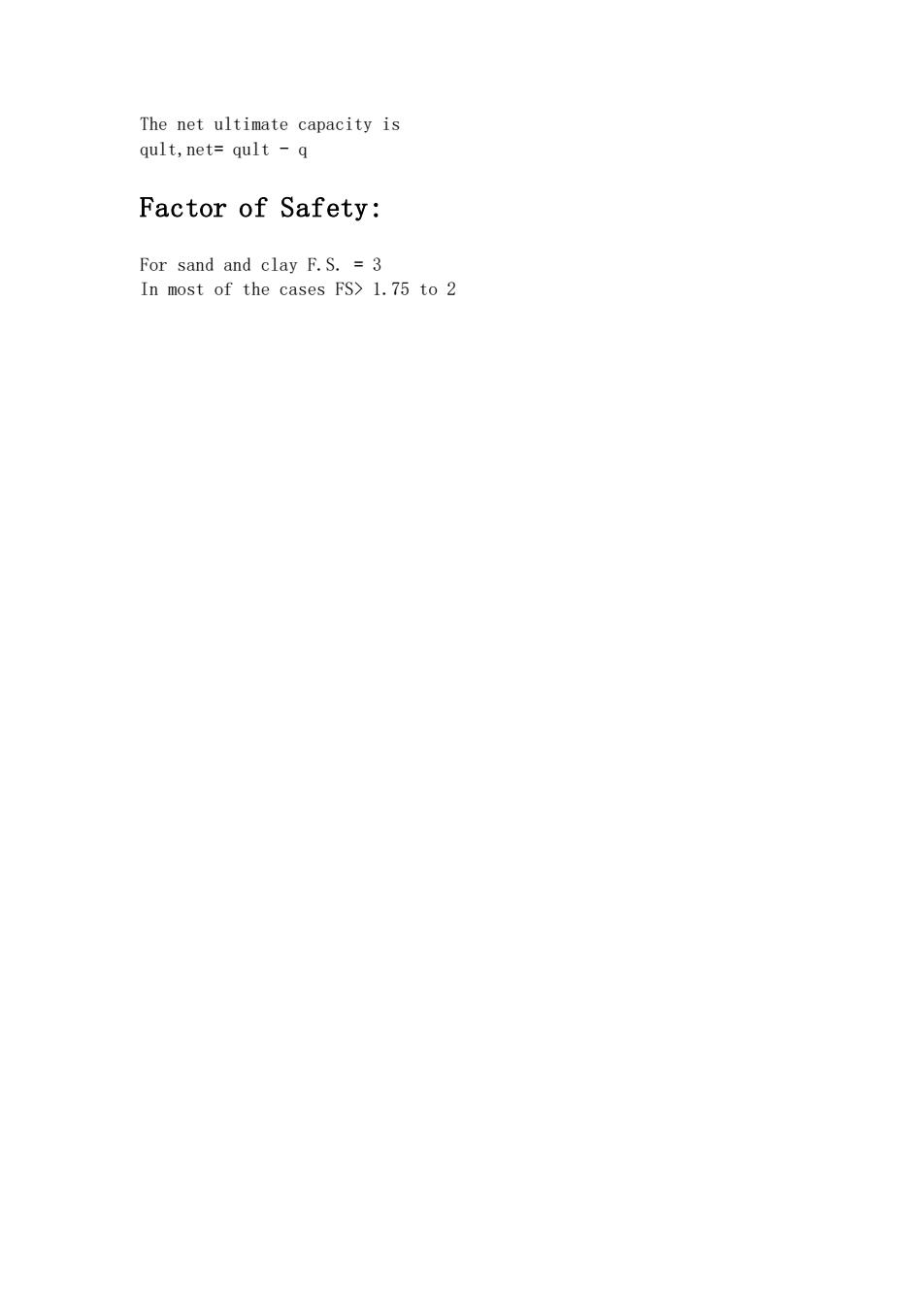
Bearing Capacity Soil bearing earth pressure theory assumes that upon exceeding a certain stress condition,rupture surfaces are formed in the soil mass.Thus,the stress causing the formation of these rupture surfaces may be considered as the Ultimate Bearing Capacity of the soil. Based on the above assumption,the bearing capacity can be determined from 1-The relationships of the principal stresses.The pertinent theories are those by Pauker,Rankine,Bell,Cassagrande and Fadum,Terzaghi and others (most common). 2-The shape of rupture surfaces,such as broken planes,circular,and logarithmic spiral 3-The mode of expulsion of the ruptured soil mass from underneath the base of the footing,i.e.one-side and two sides. Pauker's Bearing Capacity Equation(1850)(Cohesionless Soil) *One the oldest methods for determining bearing capacity of soil. *Developed based on Coulomb earth pressure theory (1776). *It is used for sandy soils only. Where s.=Ultimate Bearing Capacity *The bearing pac arly with the depth Z *This formula is valid only when Z Because the weight of the soil wedges below the footing are not included. **When f=0...... *No consideration for the cohesion of the soil (c). *This equation does consider the width of the footing 林The ne of internal friction at the vertical plane,A-Al,is not Notice: If the plastic deformation in soil was considered underneath thehoe width of the footi th the soil bearing capacity would directly be proportional to the width of the footing
Bearing Capacity Soil bearing earth pressure theory assumes that upon exceeding a certain stress condition, rupture surfaces are formed in the soil mass. Thus, the stress causing the formation of these rupture surfaces may be considered as the Ultimate Bearing Capacity of the soil. Based on the above assumption, the bearing capacity can be determined from: 1- The relationships of the principal stresses. The pertinent theories are those by Pauker, Rankine, Bell, Cassagrande and Fadum, Terzaghi and others (most common). 2- The shape of rupture surfaces, such as broken planes, circular, and logarithmic spiral. 3- The mode of expulsion of the ruptured soil mass from underneath the base of the footing, i.e. one-side and two sides. Pauker's Bearing Capacity Equation (1850) {Cohesionless Soil} ** One the oldest methods for determining bearing capacity of soil. ** Developed based on Coulomb earth pressure theory (1776). ** It is used for sandy soils only. Where su= Ultimate Bearing Capacity ** The bearing capacity increases linearly with the depth Z ** This formula is valid only when Z > 0 why ??????? Because the weight of the soil wedges below the footing are not included. ** When f = 0 ...... ** No consideration for the cohesion of the soil (c). ** This equation does not consider the width of the footing ** The angle of internal friction at the vertical plane, A-A1, is not included. Notice: If the plastic deformation in soil was considered underneath the whole width of the footing, then the soil bearing capacity would directly be proportional to the width of the footing

Rankine's Bearing Capacity Equation:(1885) Cohesionless-Soil Based on the theory of limit equilibrium in an ideal soil,Rankine calculated the bearing capacity of a soil as: where major principal stress ultimate bearing capacity =unit weight of the soil Z=critical depth of the foundation f angle of internal friction Note: 1-sin tan(45-/2)==tan2(45-f/2)1+sin tan(45+/2) *Rankine formula is similar to Pauker's equation. Therefor.the same limitations of Pauker's are applied here Bell's Bearing Capacity Equation (1915)C-f Soils Bell modified Pauker-Rankine equation to be applied for cohesive soils. He considered the equilibrium of two adjacent elements of soil prisms. Prandt1's Theory (1921) **Prandtl studied the process of penetration of hard bodies such as metal punchers into another soft homogenous isotropic rigid material. *He assumed a rigid plastic body in his system where deformations have no effect on the level od stresses in the limit equilibrium analysis. *He decided that at failure the material beneath the load ould be divided into five regions consisting of Rankin's zones and fans.The fans are sections of logarithmic spirales *From Mohr's stress theory,and using Airy's stress function,Prandtl obtained a differential equation of a second order.The solution gives the analytical expression of the ultimate bearing capacity of soil
Rankine's Bearing Capacity Equation: (1885) Cohesionless- Soil Based on the theory of limit equilibrium in an ideal soil, Rankine calculated the bearing capacity of a soil as: where = major principal stress = ultimate bearing capacity = unit weight of the soil Z = critical depth of the foundation f = angle of internal friction Note: 1 - sin tan(45 -/2) = = tan2(45-f/2) 1 + sin tan(45 +/2) ** Rankine formula is similar to Pauker's equation. Therefor, the same limitations of Pauker's are applied here. Bell's Bearing Capacity Equation (1915) C - f Soils Bell modified Pauker - Rankine equation to be applied for cohesive soils. He considered the equilibrium of two adjacent elements of soil prisms. Prandtl's Theory (1921) ** Prandtl studied the process of penetration of hard bodies such as metal punchers into another soft homogenous isotropic rigid material. ** He assumed a rigid plastic body in his system where deformations have no effect on the level od stresses in the limit equilibrium analysis. ** He decided that at failure the material beneath the load could be divided into five regions consisting of Rankin's zones and fans. The fans are sections of logarithmic spirales ** From Mohr's stress theory, and using Airy's stress function, Prandtl obtained a differential equation of a second order. The solution gives the analytical expression of the ultimate bearing capacity of soil

Terzaghi's Equation (1943) -Utilizing Prandtl's theory,Buisman (1940)expressed the maximum bearing capacity of soils by superimposing the contribution of cohesion overburden pressure,and density of the soil,His expression is commonly referred to as Terzaghi's equation.Presumably,it was associated with Terzaghi's in the English speaking countries following the publication of his book (Theoretical Soil Mechanics)in 1943. Based on Prandtl's theory of plastic failure,Terzaghi presented a modified system as illustrated below. ANALYSIS AND DESIGN OF SHALLOW FOUNDATION By far the most common structural foundation in today's construction industry is the shallow foundation.Other types of foundations,such as piles,piers,caissons,and similar deep foundations,are used primrily for major structures,not for ordinary building that constitute the overwhelming majority of all constructions. 1.ADVANTAGES OF USING SHALLOW FOUNDATION 1-Cost (affordable) 2-Construction Procedure (simple) 3-Materials (mostly concrete) 4-Labor (does not need expertise) 2.DISADVANTAGES OF USING SHALLOW FOUNDATION 1-Settlement 2-Limit Capacity Soil Structure 3-Irregular ground surface (slope,retaining wall) 4-Foundation subjected to pullout,torsion,moment. COMBINED FOOTINGS
Terzaghi's Equation (1943) - Utilizing Prandtl's theory, Buisman (1940) expressed the maximum bearing capacity of soils by superimposing the contribution of cohesion, overburden pressure, and density of the soil, His expression is commonly referred to as Terzaghi's equation. Presumably, it was associated with Terzaghi's in the English speaking countries following the publication of his book (Theoretical Soil Mechanics) in 1943. - Based on Prandtl's theory of plastic failure, Terzaghi presented a modified system as illustrated below. ANALYSIS AND DESIGN OF SHALLOW FOUNDATION By far the most common structural foundation in today's construction industry is the shallow foundation. Other types of foundations, such as piles, piers, caissons, and similar deep foundations, are used primarily for major structures, not for ordinary building that constitute the overwhelming majority of all constructions. 1. ADVANTAGES OF USING SHALLOW FOUNDATION 1- Cost (affordable) 2- Construction Procedure (simple) 3- Materials (mostly concrete) 4- Labor (does not need expertise) 2. DISADVANTAGES OF USING SHALLOW FOUNDATION 1- Settlement 2- Limit Capacity * Soil * Structure 3- Irregular ground surface (slope, retaining wall) 4- Foundation subjected to pullout, torsion, moment. COMBINED FOOTINGS

Types of Combined Footing: 1-Rectangular Combined Footing 2-Trapezoidal Combined Footing 3-Cantilever Footing 4-Mat Foundation MAT FOUNDATIONS or RAFT FOUNDATIONS Mat foundation is one type of shallow foundations. Types of Mat Foundation: 1-Flat plate----The mat is of uniform thickness 2-Flat plate thickened under columns 3-Beams and slabs 4-Slab with basement walls To Design a Mat Foundation: 1-Determine the bearing capacity of the foundation 2-Determine the settlemnt of the foundation 3-Determine the differential settlement 4-Determine the stress distribution beneath the foundation 5-Design the structural components of the mat foundation using the stress distribution obtained from (4). From Step(④) a-The mat foundation is assumed to be a rigid foundation b-The mat foundation is assumed to be a Flexible Foundation:here use Beam on Elastic Support Method. Bearing Capacity of MAt Foundations: The gross ultimate bearing capacity of a mat foundation is same as for shallow foundations: qu CNc FFF q Nq FFF 0.5 B N FFF
Types of Combined Footing: 1- Rectangular Combined Footing 2- Trapezoidal Combined Footing 3- Cantilever Footing 4- Mat Foundation MAT FOUNDATIONS or RAFT FOUNDATIONS Mat foundation is one type of shallow foundations. Types of Mat Foundation: 1- Flat plate ---- The mat is of uniform thickness 2- Flat plate thickened under columns 3- Beams and slabs 4- Slab with basement walls To Design a Mat Foundation: 1- Determine the bearing capacity of the foundation 2- Determine the settlement of the foundation 3- Determine the differential settlement 4- Determine the stress distribution beneath the foundation 5- Design the structural components of the mat foundation using the stress distribution obtained from (4). From Step (4) a- The mat foundation is assumed to be a rigid foundation b- The mat foundation is assumed to be a Flexible Foundation; here use Beam on Elastic Support Method. Bearing Capacity of MAt Foundations: The gross ultimate bearing capacity of a mat foundation is same as for shallow foundations: qu = CNc F F F + q Nq F F F + 0.5 B N F F F

The net ultimate capacity is qult,net=qult -q Factor of Safety: For sand and clay F.S.=3 In most of the cases FS>1.75 to 2
The net ultimate capacity is qult,net= qult - q Factor of Safety: For sand and clay F.S. = 3 In most of the cases FS> 1.75 to 2